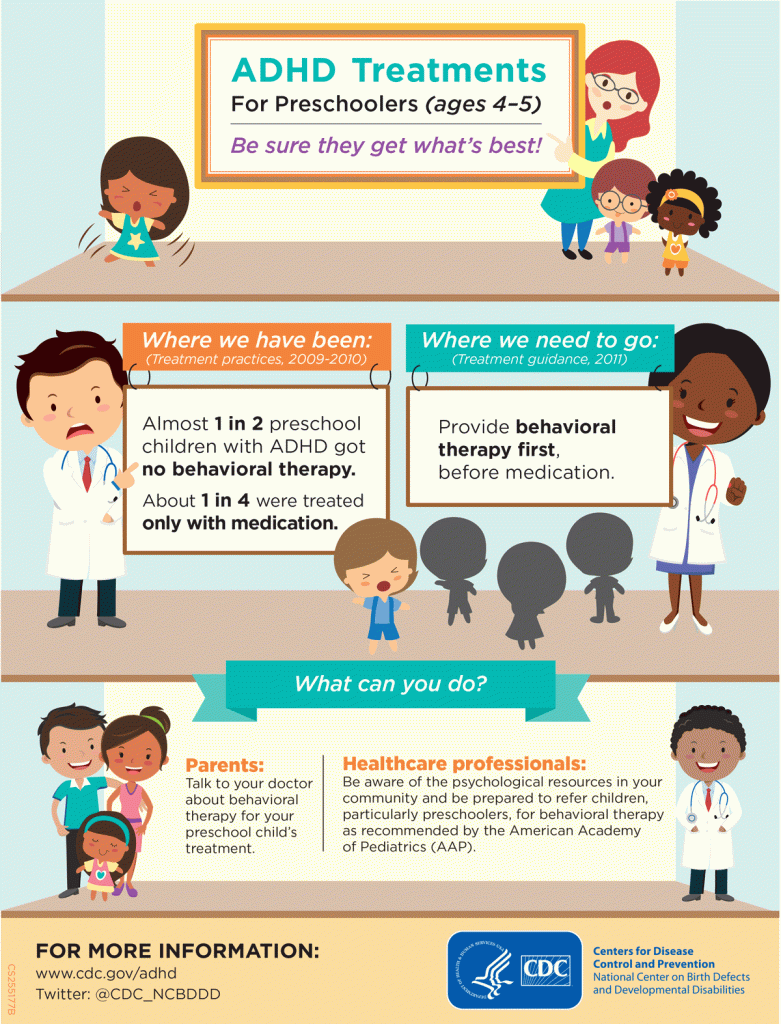An estimated 194,000 toddlers and preschoolers (age 2-5 years) in the United States have been diagnosed with Attention Deficit Hyperactivity Disorder (ADHD) and about 1 in 2 of them is not receiving the recommended treatment according to the Centers for Disease Control and Prevention. Yes, that is correct – about half of the young children diagnosed with ADHD are not receiving the appropriate treatment.
Since 2011, the treatment guidelines from the American Academy of Pediatrics have recommended that preschoolers diagnosed with ADHD receive behavioral therapy first before medication. But, almost 50% of diagnosed preschoolers received no behavioral therapy. Too many are being treated with stimulants and other psychoactive medications as the sole form of treatment.
This is a serious problem for four reasons:
- There are no valid diagnostic criteria for ADHD for children in this age range.
- Two- and three- year-olds are by nature hyperactive and often non-compliant. Child activity level essentially is at its highest from two to four and then decreases over the years, so children are at their most active phase of life in those years. Along with that fact, children of this age range have not developed the ability to put on the brakes, follow directions, and easily comply with rules. Now many parents of children diagnosed with ADHD at age 7 say that they knew their child was hyperactive at age two. This may be true. However, for every four or five children who appear to be hyperactive at age two the majority will be within normal limits by age 7. You cannot predict which child will be clinically hyperactive by school age.
- There is very little research on the impact of psychoactive medicines, particularly the stimulants, on very young children. The few studies that have been done have shown that the medicines are not very effective in this age range, have a much higher rate of side effects including appetite suppression, irritability and sleep disruption, and generally just don’t work that well.
- There are effective treatments out there to help these children and families. Systematically teaching parents to improve their behavior management skills, build in healthy routines for meals and sleep and moderate their own responses to their child’s behavior have shown to be remarkably effective. There are a group of programs that work including Triple P Parenting, the Incredible Years Program, and Parent Child Interaction Therapy. Referral for a family to the appropriate trained therapist is the best solution. The problem is families often don’t get linked to the right therapist. Another problem is that these programs are expensive in their training, often beyond the means of stressed budgets at mental health agencies.
But there is good news to help both children, parents, and therapists. Over the past several years, the CDC’s National Center for Injury Prevention and Control has analyzed all of the effective therapy programs, determined what makes them effective, and identified their common features. What Jennifer Kaminsky, PhD, found is that increasing positive parent-child interactions and learning to effectively discipline without resorting to spanking were two of the most important elements. The other two are teaching effective communication skills as well as use of social praise and rewards. Based on the existing research and this analysis, the CDC recently released a set of videos and other materials to teach these effective parenting skills on a new website:Essentials for Parenting.
So now, parents have a free effective option to choose when they find that their child is overly active and hard to manage. Therapists and pediatricians also have additional materials to use to help families. And perhaps, we can finally dispense the notion that one can diagnose a child with ADHD at age two and help parents by doing something that is effective with no side effects.
For more info, check out the CDC’s handy infographic on ADHD treatments for preschoolers.
Reposted with permission from the American Psychological Association’s Psychology Benefits Blog


